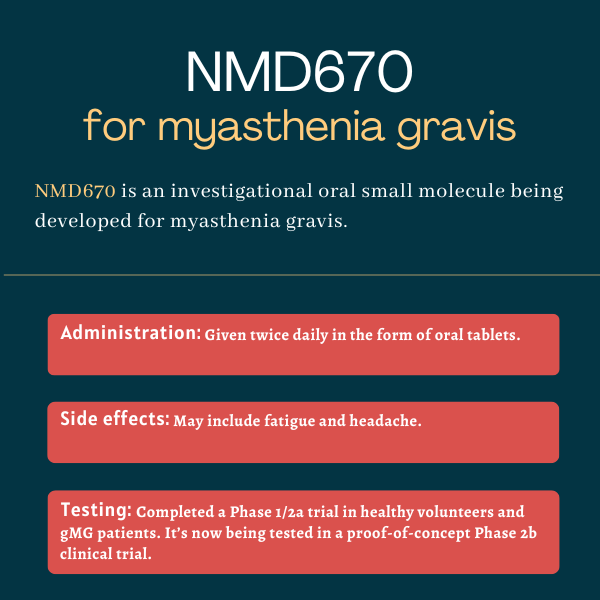NMD670 for myasthenia gravis
Last updated Sept. 23, 2024, by Joana Carvalho, PhD

What is NMD670 for myasthenia gravis?
NMD670, also known as NMDP-01, is an investigational oral therapy designed to improve nerve-muscle communication and restore muscle function in people with myasthenia gravis (MG). It is being developed by NMD Pharma to be administered twice a day in the form of oral tablets.
Now in Phase 2 clinical testing, NMD670 was previously named an orphan drug by the U.S. Food and Drug Administration for MG, a designation to support and accelerate the development of therapies for rare diseases.
The therapy is also being investigated for other rare diseases, including spinal muscular atrophy and Charcot-Marie-Tooth disease.
Therapy snapshot
| Treatment name: | NMD670 |
| Administration: | Being tested in myasthenia gravis in the form of oral tablets |
| Clinical testing: | In Phase 2 clinical testing |
How does NMD670 work in myasthenia gravis?
MG is a rare neuromuscular disease in which a person’s immune system produces self-reactive antibodies that mistakenly attack proteins involved in nerve-muscle communication. In most cases, these autoantibodies target acetylcholine receptors (AChRs) found on the surface of muscle cells.
These receptors respond to chemical signals sent from nerve cells to muscle cells, instructing them to contract. MG-causing antibodies can alter, block, or destroy AChRs, disrupting nerve-muscle communication and leading to the typical MG symptoms of muscle weakness and fatigue.
While muscles receive signals to contract through the activation of AChRs, they also receive signals to relax from another protein called skeletal muscle specific chloride ion channel (ClC-1).
NMD670 is an oral first-in-class small molecule that’s designed to inhibit the activity of ClC-1 to help shift the balance between excitatory signals telling a muscle to contract and inhibitory signals telling it to relax, in favor of muscle contraction. This could ultimately improve nerve-muscle communication and restore muscle function in MG.
How will NMD670 be administered in myasthenia gravis?
In clinical trials involving MG patients, NMD670 was given as oral tablets at various doses. Additional clinical data will be needed to determine an optimal dose to be used in people with MG.
NMD670 in myasthenia gravis clinical trials
The safety, tolerability, and pharmacological properties of NMD670 were first evaluated in a Phase 1/2a trial (CHDR1948) involving 67 healthy volunteers and 12 people with generalized MG who were positive for anti-AChR-antibodies.
The study was conducted in two major parts. The Phase 1 portion focused on assessing the safety and tolerability of single and multiple ascending doses of NMD670 in healthy volunteers. Then, in the Phase 2a portion, 12 MG patients were randomly assigned to receive a 400 mg or 1,200 mg dose of NMD670, or a placebo. This second part of the trial followed a single-dose, three-way crossover design, meaning all MG patients took one dose of all three possible treatments (the high and low NMD670 doses, and a placebo) over the course of the study, with patients acting as their own controls.
Top-line data showed NMD670 was generally safe and well tolerated in both healthy volunteers and MG patients. In the Phase 2 portion of the study, single doses of NMD670 led to improvements in the scores of the Quantitative MG (QMG) scale, a clinician-rated measure of MG severity, but only the 400 mg dose reached statistical significance compared with the placebo. Still, data showed that up to half of the patients experienced clinically meaningful responses on that scale.
Improvements were also observed in individual components of the QMG scale in most patients, despite their mild symptoms at the start of the study. These included hand grip strength, difficulty speaking, and vision problems such as double vision and drooping of the upper eyelid.
Additional tests evaluating the electrical activity of muscles and their response to nerve signals also showed NMD670 restored nerve-muscle communication as intended.
Ongoing trials
The safety and efficacy of NMD670 are being evaluated in a proof-of-concept Phase 2b clinical trial called SYNAPSE-MG (NCT06414954), taking place at sites in the U.S. and Europe.
The study seeks to enroll about 84 adults with generalized MG, ages 18 to 75, who are positive for self-reactive antibodies targeting AChR or muscle-specific kinase, another protein involved in nerve-muscle communication.
Participants will be randomly assigned to receive either a low, medium, or high dose of NMD670, or a placebo, which will be administered twice daily in the form of oral tablets for 21 days, or three weeks. The trial’s main goal is to compare changes in the QMG total score over the treatment period.
Changes in other measures of MG severity, including the MG Activities of Daily Living and the MG Composite scales, as well as in fatigue and quality of life will also be evaluated from the study’s start to day 21. The therapy’s safety will be assessed based on the incidence of adverse events and clinically significant abnormalities in laboratory parameters, vital signs, and other examinations.
The trial, which started dosing participants in June 2024, is expected to be completed in late 2025.

Common side effects of NMD670
Clinical testing of NMD670 in people with MG is still in its early stages, so little is known about its safety profile in this patient population. In a Phase 1/2 trial involving 12 patients with generalized MG, the incidence of treatment-related side effects was similar after a single dose of NMD670 or a placebo. Side effects that were most commonly reported after NMD670 treatment included fatigue and headache.
Myasthenia Gravis News is strictly a news and information website about the disease. It does not provide medical advice, diagnosis, or treatment. This content is not intended to be a substitute for professional medical advice, diagnosis, or treatment. Always seek the advice of your physician or other qualified health provider with any questions you may have regarding a medical condition. Never disregard professional medical advice or delay in seeking it because of something you have read on this website.
Recent Posts
- A day in the water is just what the doctor ordered
- How I keep moving forward in life with myasthenia gravis
- Myasthenia gravis gave me something unexpected: A loud voice
- The Importance of Self Advocacy: A Delayed Diagnosis Leads to Years of Uncertainty
- The weight of asking for help; the difference an act of service makes
Related articles





